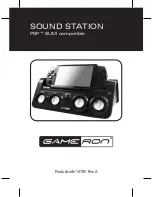
8
InSTAllATIon
1.
For optimum audibility of the high frequencies we recommend installing the tweeter of the studio monitors at eye-level; nutzen Sie dazu
gegebenenfalls einen geeigneten Lautsprecherständer. Be sure to use an even, stable underground; if necessary, use sound proofing material.
2. These studio speakers are nearfield monitor speakers which can be set up at a short distance to the listener.
3. To avoid reflection from walls that are too close (e.g. room corners), turn the speakers slightly towards you. To optimise your ambience
acoustics, use sound absorbing plates.
4. When using a microphone, be sure to position it at all times behind the loudspeakers to avoid potential feedback when activated.
Nearfield Installation
In control rooms monitors are usually placed on the studio console (face level). For this purpose the positioning of the monitors and the listener
should be arranged in an equilateral triangle. In this installation the monitors are placed at a 60° angle to the listening position.
Mid-field Installation
This installation is more or less the same as the close-field installation. This variant is usually used if the monitors are too large or heavy to be
placed on the studio console. This setup offers a larger sweet spot and a better spacial acoustic imaging. In this installation the monitors‘ woofer
should be positioned above the height of the studio console.
connecTIonS
1.
Connect your audio source to the Signal Input -6- (XLR), -7- (6.3 mm jack) or -8- (RCA). Depending on the input being used, the corresponding
input has to be selected via the Input Select Button -3- or -15-. The respective LED -5- will be lit.
2. Connect both monitor speakers via the Link Connection -13- in order to control both speakers with the External Wave Control.
3. Connect the External Wave Control to the corresponding connection -12-.
4. Connect the mains adapter to the corresponding connection -18- and to your mains outlet.
ENGLIS
CH






































